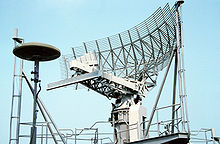AN / SPS-49
The AN / SPS-49 is a two-dimensional airspace search radar with a long range. It comes from the US Corporation Raytheon and on ships, the currently most widely used radar of its kind.
development
The first prototype of the SPS-49 was installed aboard the destroyer USS Gyatt in 1965 . Despite successful tests, the radar was not taken into series production, because at the same time an improved version of the AN / SPS-40 had similar performance parameters, but was considerably cheaper. The development of the SPS-49 did not start again until 1970. The first serial system was then installed on board the USS Dale in 1976 , although it is a modification of the original system. Over time, the radar was produced more than 200 times and used on a wide variety of ships, replacing the AN / SPS-37 , AN / SPS-43 and also AN / SPS-40 radar devices . The SPS-49 is also often installed permanently on beaches in order to monitor the seaward airspace.
description
The SPS-49 is a relatively large and bulky construction. Due to its large number of mechanical components, it was initially very prone to failure (one failure every 60 hours). However, this problem has largely been solved with the advancing further development, so that today's variants work with significantly less interference (one failure every 300 hours). When the system was officially introduced, it already had very good performance parameters for the time, especially in the areas of range, ECCM and clutter suppression. It was also possible to detect supersonic and low-flying targets with a small radar cross-section (e.g. anti-ship missiles ) at considerable distances. Several separate antennas for IFF interrogation and sidelobe suppression are also available. The system was designed to be modular from the start and equipped with digital signal processing, which also has extensive self-diagnostic capabilities.
variants

- AN / SPS-49 (V) 1: Basic version with MTI and side lobe suppression .
- AN / SPS-49 (V) 2: Without side lobe suppression for the MTI mode
- AN / SPS-49 (V) 3: A (V) 1 system with a "Radar Video Processor" (RVP)
- AN / SPS-49 (V) 4: Modified (V) 2 system, also with the new RVP
- AN / SPS-49 (V) 5: Variant with improved ECCM capacities, automatic target acquisition and digital interface . Developed as part of the New Threat Upgrade program in the early 1980s.
- AN / SPS-49 (V) 6: A (V) 3 system with improved cable shielding and a new cooling system
- AN / SPS-49 (V) 7: (V) 5 variant with the (V) 6 cooling system
- AN / SPS-49 (V) 8: A modified (V) 5 system, which is now with the Aegis combat system are connected could
- AN / SPS-49 (V) 9 MPU: This variant is a comprehensive upgrade, which significantly increased the performance of the radar. The improvements include larger ECCM capacities, better location of targets with small radar cross-sections, improved clutter suppression and reduced response times.
- AN / SPS-49A (V) 1: Developed in the 1990s. Includes clutter suppression with even higher performance and various improvements to the electronics. All US Navy SPS-49 radars will be upgraded to this standard.
Platforms
- Frigates: Oliver Hazard Perry class , ANZAC class , Halifax class
- Cruisers: Ticonderoga-class , Leahy-class , Belknap-class , USS Long Beach
- Destroyer: Farragut class
- Battleships: Iowa Class
- Aircraft carriers: Nimitz-class , Wasp-class , USS Enterprise , Forrestal-class , Midway-class
- Amphibious warfare ships: Tarawa Class , Whidbey Island Class , Harpers Ferry Class
Technical specifications
- Weight (above / below deck)
- SPS-49 (V) 1: 1,456 kg / 6,255 kg
- SPS-49 (V) 5: 1,425 kg / 6,325 kg
- Antenna dimensions (W × H): 7.3 m × 4.3 m
- Frequency range : 850 - 942 MHz (48 adjustable frequencies)
- Impulse power : 360 kW
- Average power: 13 kW
-
Opening angle :
- 3.4 ° horizontal
- 11 ° vertical
- Pulse repetition frequency : 280, 800 or 1000 Hz
- Transmission time: 2 or 125 µs
- Distance resolution : 0.05 km
- Angular resolution : 0.5 °
- Antenna rotation time: 5 or 10 s
- Antenna gain : 29 dB
- Range ( RCS = 1 m²): 400 km
- Minimum range: 0.93 km
- Maximum detection height: 4.56 km
Web links
- Federation Of American Scientists
- The Warfighter's Encyclopedia (English) ( Memento of 5 November 2004 at the Internet Archive )
